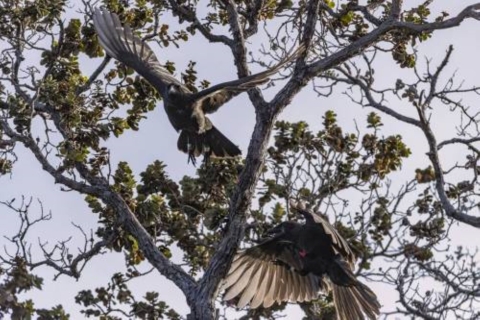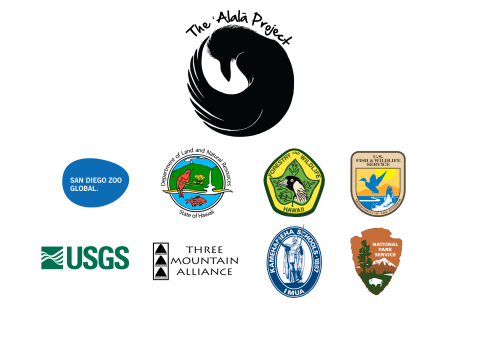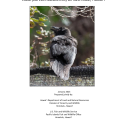States
HawaiiEcosystem
ForestʻAlalā or Hawaiian crow (Corvus hawaiiensis) has been extinct in the wild since 2002, living only in captivity at the Keauhou (Hawaiʻi Island) and Maui Bird Conservation Centers (Maui), which are managed by San Diego Zoo Wildlife Alliance Hawai‘i Endangered Bird Conservation Program. The ʻAlāla Project, a partnership between the U.S. Fish and Wildlife Service Pacific Islands Fish and Wildlife Office , State of Hawai‘i Department of Land and Natural Resources (DLNR) Division of Forestry and Wildlife (DOFAW), and San Diego Zoo Wildlife Alliance, is working to support the conservation and recovery of ‘alalā, with the goal that it can return to the wild and fulfill their ecological and cultural roles in the forests of Hawai‘i.
NEWS
- NEWS RELEASE: U.S. Fish and Wildlife Service, State, Announce Final EA and FONSI for Pilot Release of ʻAlāla on East Maui
- FINAL ENVIRONMENTAL ASSESSMEMT
- FONSI
- ERRATA
The ʻAlalā Project
- The ʻAlalā Project Homepage
- The ‘Alalā Project Facebook
- The ʻAlalā Project Blog
- FAQs
- Past ʻAlalā Stories
Meet ʻAlalā
Approaches to Recovery
In 2016, the ‘Alalā Working Group, a partnership coordinating ‘alalā reintroduction on Hawai‘i Island, initiated a new strategy to return the birds to the forest. Biologists set out to incorporate the birds’ personalities and group dynamics, along with detailed habitat selection and an innovative approach to training the birds to avoid predators.
During releases at Pu‘u Maka‘ala Natural Area Reserve from 2016-2019 on Hawai‘i Island, some progress was made. One pair of ‘alalā nested (although no young grew to maturity) and some birds successfully avoided depredation by ‘io or Hawaiian hawk (Buteo solitarius) for more than two years. Unfortunately, the rate of ʻalalā mortalities due to ʻio predation accelerated in summer of 2020 and surviving birds had to be returned to human care.
Since 2021, renewed efforts to address ‘io predation on ‘alalā includes research on ‘io behavior and habitat use that will inform site selection and release strategies for future ‘alalā releases on Hawai‘i Island. While ‘io research continues on Hawai‘i Island, simultaneously the ‘Alalā Project is planning a pilot release on Maui to evaluate whether ‘alalā can survive and breed in wet forest habitat on east Maui—where ‘alalā or a similar crow species lived historically and there is no ‘alalā predation threat from ‘io (‘io are only present on Hawai‘i Island).
“Recovering threatened and endangered species is bigger than any one community or agency. Together we can ensure a healthy future for not only the birds, but the forest ecosystem as a whole.”
- Michelle Bogardus, Deputy Field Supervisor, Pacific Islands Fish and Wildlife Office
About ‘Alalā
Click here to view recovery documents.
The ‘alalā is a medium-sized crow, 18 to 20 inches in length. The sexes are similar in color and size. The ‘Alalā is a duller black than its North American cousins, with brown-tinged wings, and the throat feathers are stiff with hairlike webs and grayish shafts. The bill and legs are black.
‘Alalā are critical parts of Hawaiʻi's ecosystem as the seeds they eat and disperse help support native plant species. Bringing back ʻalāla to the wild would help the recovery of Hawaiʻi's forest.
The ʻalalā is the only remaining crow in Hawaiʻi and is a valuable biological and cultural resource. In Hawaiian culture, ʻalalā are regarded as ʻaumākua (family guardian) and its cry was considered a warning not to enter certain places. ʻAlalā are included in the Kumulipo, the Native Hawaiian creation chant that details the emergence of all life forms. This acknowledgement is significant as it demonstrates the familial relationships and connections that Native Hawaiians continue to have with ‘alalā to this day.
HABITAT & BEHAVIOR:
Endemic to the island of Hawaiʻi, ʻalalā favored the upland forests between 3,000 to 6,000 feet in elevation on Hualālai and Mauna Loa. They were most often found in ‘ōhi‘a or ‘ōhi‘a-koa forests. The ‘alalā is omnivorous, preferring fruits of native trees and shrubs, but also eats insects, mice, and sometimes the nestlings of small birds.
Breeding usually occurs from March through July. The ‘alalā lays one to five greenish-blue eggs, but generally only two hatchlings typically fledge. The family groups stay together until the young learn to fly and eat on their own. The ‘alalā has a crow-like call: “cawk” or “ca-wak”, but they also make many other sounds. Their vocalizations are more musical and varied than most other crows.
The ‘alalā’s natural predator is the ‘io (Hawaiian hawk). Chicks are very vulnerable to tree-climbing rats, and after they leave their nests, to cats, dogs, and mongooses.
PAST & PRESENT:
‘Alalā were once abundant in the lower forests of the western and southern sides of the island of Hawai‘i. Hunting, disease, depredation bynonnative mammals, and loss of suitable habitat were all factors in the decline of the ‘alalā. The last two wild ‘alalā vanished from their territory in South Kona in 2002. Read More!
ʻAlalā Release on Maui
The State of Hawaiʻi DLNR and the Service (Resource Agencies) jointly proposed a pilot release of ʻalalā to evaluate the suitability of East Maui as habitat for the ʻalalā, an ecological and culturally important species. This effort is consistent with the statutory missions and responsibilities of the DLNR and the Service.
ʻAlalā is known historically from the island of Hawai‘i and currently survives only in captivity at two conservation breeding centers, one on Hawai‘i Island and one on East Maui. There have been three attempts to release ʻalalā on Hawaiʻi Island. These were unsuccessful, largely due to predation on released ʻalalā by ʻio. ‘Io inhabits Hawai‘i Island only. Sub-fossil bones of ‘alalā or a crow species very similar to ‘alalā have been found on East Maui. Montane native forest on East Maui is similar to native forest on Hawaiʻi island, except East Maui forest is generally wetter. The multi-stakeholder pilot project will allow managers to evaluate whether ʻalalā will breed in wet forest on East Maui and have better survival in habitat where ʻio are absent.
Final Environmental Assessment
A draft EA was released on October 16, 2023. The Service and State held two separate 30-day public comment periods, as well as public meeting at Kula Elementary School on Maui, on November 8, 2023. All comments were considered the final EA.
A finding of no significant impact (FONSI) and Final EA were issued on February 29, 2024, to conclude the NEPA process and document the decision of the final EA. A FONSI is issued when environmental analysis and interagency review during the EA process find a project to have no significant impacts on the quality of the environment. The statements and conclusions reached in this FONSI are based on documentation and analysis provided in the final EA.
The EA evaluates Kīpahulu Forest Reserve and Koʻolau Forest Reserve as release sites. The National Park Service is a cooperating agency on this EA due to the proximity of the project area to Haleakalā National Park. The EA provides background information concerning ʻalalā biology and outlines the actions, impacts, and strategies to avoid and minimize potential negative effects of the proposed release of ʻalalā within the project area on East Maui. This project is a joint effort of the Service and DLNR and complies with each agencies’ obligations under the National Environmental Policy Act (NEPA) and Hawaiʻi Revised Statutes (HRS) Chapter 343, DLNR and the Service.
Although the EA was a cooperative federal and state compliance document satisfying both NEPA and the Hawai‘i Environmental Policy Act (HEPA) regulations, this FONSI analyzes only the impacts under current NEPA standards.
The FONSI and final EA directly support the U.S. Department of the Interior’s Strategy for Preventing the Extinction of Hawaiian Forest Birds.
Frequently Asked Questions
Visit our FAQ gallery for a series of short videos produced by project partner Hawaii DLNR answering some of the most common questions people have.










